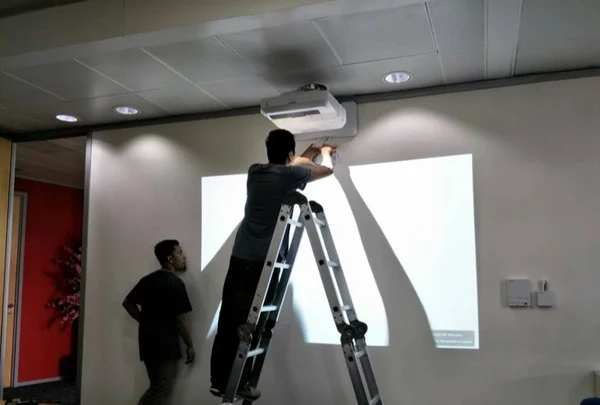Here’s a step-by-step guide for installing a projector for the first time, whether it’s for a home theater, office, or classroom. I’ll keep it practical so you can follow it without guesswork.

1. Choose the Right Location
- Check throw distance (distance from lens to screen) in your projector’s manual — every model is different.
- Ensure the wall or screen is flat, white/light gray, and free from glare.
- The projector should be centered horizontally to the screen.
💡 Tip: If ceiling-mounting, make sure you have power and cable routing planned before drilling.
2. Decide on Mounting Type
- Tabletop / Shelf: Quick setup, portable, no drilling.
- Ceiling Mount: Saves space, gives cleaner look but needs careful alignment.
- Wall Mount (Short-Throw): Ideal for classrooms or small rooms.
3. Gather Tools & Materials
- Projector & remote
- Mounting kit (if ceiling/wall mounting)
- HDMI or VGA cable (and audio cable if needed)
- Power extension cable (if outlet is far)
- Drill, screws, and wall anchors (for mount)
- Measuring tape & spirit level
4. Mount or Position the Projector
For Table/Shelf:
- Place on a stable, level surface.
- Align with center of screen.
- Adjust height with built-in feet.
For Ceiling:
- Mark mounting holes using template from your mount kit.
- Drill holes and install wall anchors (if not into a beam).
- Secure mount plate to ceiling.
- Attach mount bracket to projector.
- Lift and secure projector to mount.
5. Connect the Cables
- Video: HDMI (best quality), VGA (older devices), or USB-C/DisplayPort (modern laptops).
- Audio: Connect to projector speakers or external sound system.
- Power: Use a surge protector to prevent damage.
💡 If ceiling-mounted, route cables through cable raceways or in-ceiling for a clean look.
6. Power On & Adjust Image
- Select correct input source on projector.
- Use the focus ring to sharpen image.
- Adjust zoom to fit screen size.
- Use keystone correction or lens shift to square the image.
7. Optimize the Setup
- Set projector to native resolution for best picture.
- Adjust brightness, contrast, and color to match room lighting.
- In bright rooms, use an ambient light rejecting (ALR) screen for better clarity.
8. Test & Fine-Tune
- Play a video or presentation to check for sharpness and alignment.
- Ensure no cables are loose.
- Tighten all mount screws if ceiling-mounted.
Final Safety Checks
- Ensure ventilation is not blocked (leave at least 2 feet clearance around vents).
- Avoid placing projector near heat sources.
- Turn off and unplug when not in use for long periods.
